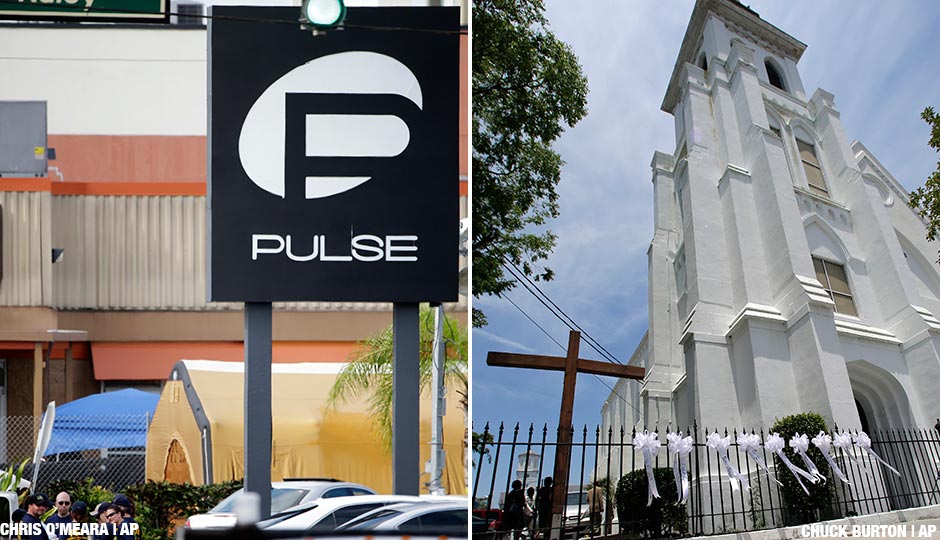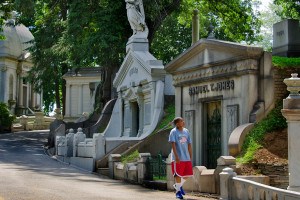Tre Johnson writes at Dearth of a Nation.
Orlando and Charleston Were Hate-Fueled Attacks on Safe Spaces

Left: Pulse nightclub in Orlando. Right: Nine ribbons in honor of the victims are shown in front of Mother Emanuel AME Church in Charleston, S.C., Friday, June 17, 2016 on the anniversary of the killing of nine black parishioners during bible study.
In 1992, as a 14 year-old boy I saw Spike Lee’s Malcolm X at Princeton MarketFair’s movie theatre with my cousin Sean. Seeing the movie was an almost religious experience itself; I hadn’t known much about Malcolm at that point, and I had also never experienced an all-black movie experience at that point. I left elated but also guarded; Malcolm’s rise to influence and then subsequent assassination left me drained and weary. The movie closed with a legacy-affirming montage of blacks standing up and proclaiming “I am Malcolm X” — signaling the idea that what he was will be and will live on no matter what.
The movie was about the importance of being vigilant when you’re part of a hated group; that at any given moment something terrible could happen because your very existence was hated. This meant that harm could come at any place, at any time.
The movie provided insight into what this paranoia looked like during the 1960s: Think of the classic photo of Malcolm X standing in his living room window, or at church where Malcolm was ultimately murdered. As black folks forged toward justice, the need to have an eye on the prize meant that you also had to have an eye for any potential threat.
All of this was symbolized in the succinct advice given at one point in the film: Never sit with your back to the door. It was a reminder that there was always a gun scope’s reticle trained on you.
There’s been a trained reticle on marginalized populations for a long time now and one of the best ways that this trained eye has been maintained on them has been through the violent disruption of peaceful spaces. If you want to unnerve the heart, the psyche, the security and the community of a key group, there’s no better place to strike than the places that they hold most sacred. America has a long history with this type of domestic terrorism, and it’s been most uniquely applied to minority and oppressed groups. Sunday morning’s “Latin Night” mass murder at Pulse, a popular gay club in Orlando, was the latest in the steady practice of destroying sanctuaries in the vein of America’s greatest emotion: hate.
And Friday marks the one-year anniversary of another prime example: Sunday morning of June 17, 2015, was when 21-year-old shooter Dylan Roof walked into Emanuel African Methodist Episcopal Church in Charleston, South Carolina, shooting and killing nine black people.
These two incidents will remain stains on the country, and rightly so; they represent us not only at our worst as a country, but continue to lay bare the idea that even as we preach unification and color-blind equality, too many of us — black, Latino, gay, female — feel the heat of the hate reticle on our backs.
It’s not hard to see why, either. There’s a temptation to classify attacks like Charleston and Orlando as “mass shootings.” While this is true, it doesn’t speak to the legacy of paranoia that many people — in particular those of color — have already felt for ages now. In America, each generation minorities have been given reason to watch the door, so to speak.
In 1923 Rosewood, Florida, a black-founded town intended to start their own lives and community was literally burnt to the ground.
In 1963 in Birmingham, Alabama, four little black girls were blown to pieces by sticks of dynamite at the 16th Street Baptist Church.
In 1985, the MOVE bombings in Philadelphia.
And now Charleston and Orlando have happened.
Generation after generation collectively watching the door.
This isn’t to equivocate the tragedies that happened in the past in solely black terms or anguish; this is about conjoining these tragedies within the wider framework of hate. Understandably, many people want to focus on the methodology of these attacks; we look at these situations and apply a great deal of thought to gun reform because that’s easier to grapple with than the notion of figuring out how we can reform hate.
But again, this is where the approach threatens to ring false. Marginalized communities have seen every sort of weapon — dynamite, bombs, dogs, hoses, guns, rope, etc. — used against us in every sanctuary possible — school houses, churches, clubs and homes — making it hard to impress upon folks living in a terroristic society that anything resembling rational reform or a safe space exists anymore.
Because hate needs no specific weapon to inflict terror, it only needs opportunity and support. And in America, we’ve willingly provided such opportunities twenty times over. Our instances and incidents of hatred are anything but coincidence; they’re the realistic, albeit extreme, outcomes of everything from legislation on women’s reproductive rights, to voter suppression; lax LGBT protections to housing and schooling segregation. Every time we signal that segments of populations in our society are not equals we not only justify people’s hatred, we reignite the notion of hunting season.
The notion of sanctuary has come under attack in our nation’s political fight over immigration. The notion of safe spaces have become almost a punch line in the debates over free speech on campus. But when Pennsylvania doesn’t cover LGBTQ communities under its hate crime statutes, and when those with hate in their hearts have revived the ugly tradition of domestic terrorism, the imperative to protect safe spaces and sanctuaries is greater than ever.
This type of domestic terrorism disrupts sanctuary, civility and routine; it not only takes lives but derails them, settling into the psyche of too many non-white, non-straight Americans who feel the need to gauge the temperature of a room, a social setting, conversations.
Last Sunday morning, hours after the news of the Orlando massacre and as the numbers and the narratives were still being accounted for, I walked the streets of the Odunde Festival. As I waded through wave after wave of beautiful black festival goers, music and food, something struck me: We were sitting targets. If someone was brazen enough to walk into a club and open fire, how easy would it be here? As I scanned the crowd periodically, I couldn’t help but imagine what it would look like if something like Orlando were happening right then.
While it might seem confounding and obnoxious for people who don’t understand these experiences to grasp such a need for vigilance, it’s hard not to counter with “try living with it.” Or better yet, try dying from it.


